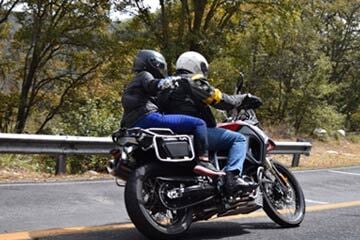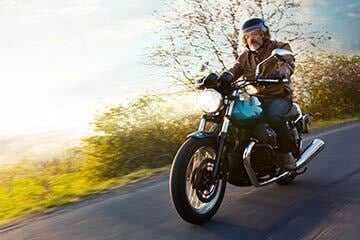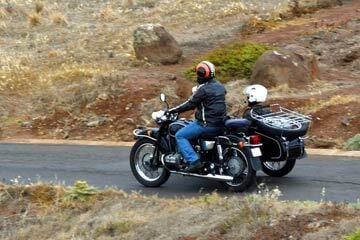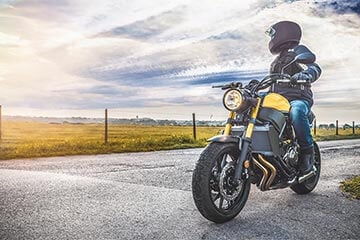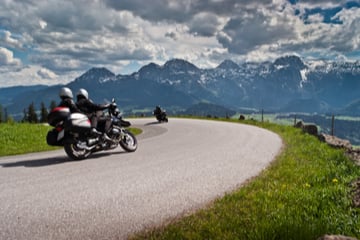Thinking about becoming a biker? Before you can get your full motorbike licence, there are a few tests to pass.
As well as some basic training with CBT test, there are theory and practical tests to consider. But with enough preparation, you should be able to start riding in no time. Here's what you need to do.

How do I get a motorcycle licence?
Your first step is to get a provisional motorbike licence, this costs £34 online. To get started, you'll need to provide some basic forms of ID, including your:
- Passport
- National Insurance number
- Proof of address
After you've applied, you should receive email confirmation. It's a fairly quick turnaround, you should get a provisional licence within a week.
To apply for your provisional licence from DVLA online you must be at least 15 years and 9 months old. You also need to be able to read a number plate from 20 metres away.
Do I need a CBT?
If you’ve got a full car driving licence, you might be able to ride a 50cc moped without any training. But this depends on when you passed your driving test.
If you passed before 1 February 2001 there’s no need to take Compulsory Basic Training (CBT) to ride a moped up to 50cc. But you do need a CBT to ride a motorbike.
If you passed on or after 1 February 2001 you must take the CBT even to ride a moped on public roads.
What’s a CBT test?
Before riding your motorbike you need to complete your Compulsory Basic Training (CBT). The emphasis here is on the words ‘compulsory’ and ‘training’. There’s no pass or fail test here, despite the common phrase being a 'CBT test'.
Once you've finished this 1-day course you can ride a motorcycle up to 125cc if you’re 17 years old, or a moped if you’re 16.
The CBT is only valid for 2 years, and you must display your L plates at all times. You can’t ride on motorways, but you can ride on dual carriageways.
The CBT consists of 5 parts and is an excellent primer for all biking matters, off and on-road. You're expected to have a basic knowledge of traffic signs and The Highway Code before you start.
The training covers:
- Eyesight and basic maintenance checks
- Braking and manoeuvring
- Changing gear and riding behaviour
- Riding in typical traffic conditions and U-turns
- Emergency stops
- At least 2 hours out on the road with your instructor
With your CBT certificate you have 2 years to pass your other motorbike tests.
If you take your own motorbike to your CBT, make sure it’s taxed and you’ve got a motorbike insurance policy in place.
Compare motorbike insurance quotes
How much does a CBT cost?
It varies, but most courses usually cost between £120-£300. Depending on the venue, this could also include:- Helmet hire
- Insurance cover
- Flexible cancellation options
- Fuel costs
If you’ve trouble finding a course near you then the government’s CBT portal should help.
If you ride your motorbike on a public road before taking your CBT, you could get up to 6 points on your licence. You might also get a fine of up to £1,000.
How do I prepare for a motorcycle CBT test?
Before you take your CBT, it helps to be familiar with the rules of the road and the basics of riding a motorcycle:
- Read the Highway Code, paying particular attention to rules 83-88
- Learn the most common road signs that you're likely to encounter
- If you wear prescription glasses, make sure your prescription is up to date
You can also buy the Official Learning to Ride guide from the DVSA, which costs £14.99.
How much does getting a motorbike licence cost?
Once you've finished your CBT, there are still a few steps left to take. And each of these steps comes at a cost. Let's break it down:
How much do motorbike lessons cost?
Motorbike lessons costs start from around £20 an hour. The total cost depends on how many lessons you take before passing your motorbike test. But in some cases you can pay for multiple lessons for a slightly discounted rate.
Using learning to drive as our guide, the DVLA estimates you need around 47 hours of official lessons.
That comes to around £940 in total for motorbike lessons. There are lots of training schools with different pricing, so it’s worth shopping around.
How much does the motorcycle theory test cost?
The theory test costs £23 and the price is the same for evenings, weekends and bank holidays.
How much does the motorbike test cost?
The practical motorbike test comes in 2 modules.
The Module 1 off-road test costs £15.50 and the Module 2 road test costs £75 in normal working hours. This goes up to £88.50 at other times including weekends.
Adding all those costs up, we get:
| Test | Cost |
|---|---|
|
Provisional licence
|
£34
|
|
Compulsory Basic Training
|
£150
|
|
Theory test
|
£23
|
|
Practical test: module one
|
£15.50
|
|
Practical test: module two
|
£88.50
|
|
Total
|
£311
|
|
Total including lessons
|
£1,251
|
How do I get a full motorbike licence?
After the CBT you might be raring to start riding now you know the basics. But, sadly you're still only about half way there. Now come the actual tests. Here's a quick rundown of what you need to do next to get your full motorcycle licence:
- Pass your motorbike theory test - 43/50 questions right
- Pass your hazard perception test - 44/75 points
- Pass the Module 1 (off-road) motorbike practical test
- Pass the Module 2 (on-road) practical test
- Upgrade your licence to full
What should I expect at the motorcycle theory test?
You can book your motorbike theory test online or over the phone.
The motorbike theory test involves:
- A 50-question multiple choice test and
- A hazard perception test. This second part uses video clips.
The multiple question test uses real-life situations and case studies. While there are 50 questions in total, you only need to get 43 out of 50 right.
Here are a few examples of the questions you might get.
- Question: What should you use to clean visors and goggles?
- Possible answers: Petrol, white spirit, anti-freeze or soapy water?
- Question: At an incident, someone is suffering from severe burns. How could you help them?
- Possible Answers: a) Apply lotions to the injury. b) Burst any blisters. c) Remove anything sticking to the burns. d) Douse the burns with clean, cool water.
- Question: Which lane must not be used by a motorcyclist?
- Possible Answers: a) Crawler lane. b) Overtaking lane. c) Acceleration lane. d) Tram lane.
The test covers all aspects of riding, so it’s worth getting as much practice as you can before booking the test.
The hazard perception test contains up of 14 clips. There’s a maximum of 75 points but you only need to get 44 to pass. Each ‘hazard’ is worth 5 points. Unlike the first multiple choice test, you can’t go back to your previous answers.
What’s helpful is that you can practice both parts of this theory test online for free. There’s also a bunch of books, online videos and apps out there to support you.
How does the motorcycle practical test work?
The practical motorbike test contains 2 modules.
Motorbike practical module 1
Module 1 is an off-road riding test. This test lasts around 20 minutes and tests your motorbike-handling skills.
This module covers basic road skills including some motorbike-handling. The examiner should be looking at any potential faults that might put anyone at risk.
Even though it’s a highly-controlled environment, treat the test as if you’re on a public road.
Module 1 includes:
- Wheeling the moped or motorcycle and using the stand
- Doing a slalom and figure of 8
- A slow ride
- A U-turn
- Cornering and a controlled stop
- Cornering and an emergency stop
- Cornering and hazard avoidance
You must perform the hazard avoidance and emergency stop exercises:
- If you're on a moped, at a minimum of 19 mph
- If you're on a motorcycle, at a minimum of 31 mph
As long as you make no major faults and no more than 5 minor faults you should pass.
Even then the examiner might give you a rundown of possible areas areas you can improve on. If not, it's worth asking.
If you’ve passed, congratulations! This means moving onto Module 2. If you haven’t passed you’ll need to wait 3 working days before re-attempting the test.
If you’ve already booked your Module 2 test and failed Module 1 then you might need to change this date.
Motorbike practical module 2
Module 2 takes around 45 minutes. and begins with reading either:
- A new-style number plate from 20 metres away
- An older-style number plate from 20.5 metres away
Then there are some ‘show me, tell me’ safety questions. This part of the test is where you show your awareness of how your motorbike works. Don’t worry, you’re not expected to know anything too technical.
Some of these ‘show me, tell me’ questions include:
- Where is the brake fluid reservoir and how would you know if it’s safety topped up?
- What about the condition of your bike’s chain? How could you check for tension and alignment?
- How would you check the brakes – and what might you need to look for?
- What advice would you give a pillion passenger if they’d not been on the back of a motorcycle before?
Then the riding starts, split into 2 parts. The first part covers stopping, hill starts and pulling out from parked vehicles
The second part is an independent ride. The examiner gives you a basic set of directions and it's up to you to follow all road signs to get there.
How do I upgrade my motorbike licence?
Motorcycle licences are a bit less straightforward than driving a car. What route you take depends on the type of motorbike you want to ride, and your age. The process is so complicated that the DVLA has created a flow chart to help navigate it.
So, let's clear things up a bit:
A1 light motorcycle licence
You need to be at least 17 years old to get this licence. You must also:
- Complete the CBT - this lets you ride 125cc bikes with an L-plate for 2 years
- Pass the theory test
- Pass Modules 1 and 2 of the practical test
The A1 licence lets you ride motorcycles up to 125cc and carry a pillion passenger.
A2 motorbike licence
You need to be at least 19 years old. With an A2 licence you can ride motorbikes with a maximum power output of 35kW.
- If you have a provisional licence, you must complete the CBT and pass all theory and practical tests
- If you've had an A1 licence for less than 2 years, you must pass both the theory and practical tests
- If you've had an A1 licence for more than 2 years, you must pass the practical motorbike tests
You can also ride on motorways and carry a pillion passenger.
Category A bike licence
You must be at least 21 years old to get a Category A motorbike licence, which lets you ride a motorbike of any size.
- If you're between 21 and 23 years old, you need to have held an A2 licence for at least 2 years. You then need to pass the practical motorbike test on a 595cc motorbike.
Once you reach 24, your path to a full motorbike licence depends on what licence you already have:
- If you have a provisional licence, you need to pass the CBT as well as the theory and practical tests
- If you have an A1 licence, you need to pass the theory and practical tests
- If you've held an A2 licence for less than 2 years, you need to pass the theory and practical tests
- If you've had an A2 licence for more than 2 years, you just need to pass the practical tests
What is the Direct Access Scheme and how much does it cost?
A Direct Access Scheme (DAS) helps you get a full motorcycle licence without needing any previous licences. You need to be over 23 years of age and have some car driving experience.
You still need a CBT and to have passed the theory test, though.
Prices vary, but expect to pay around £700 for the course.


